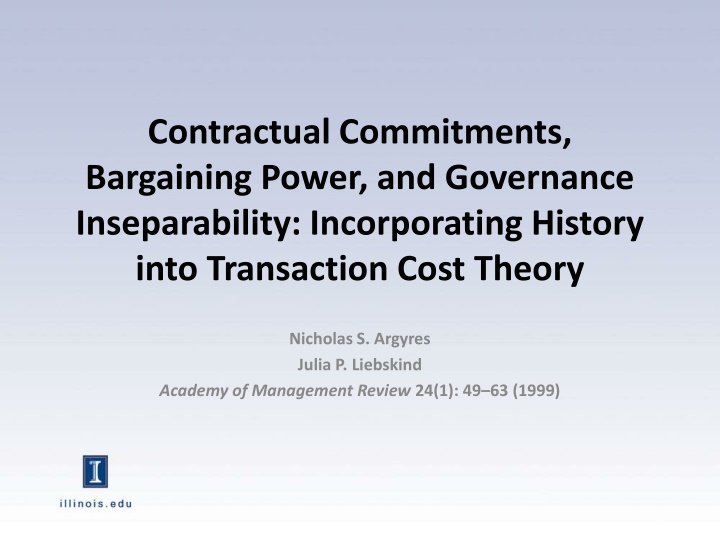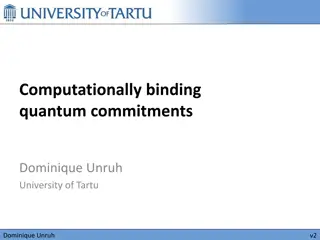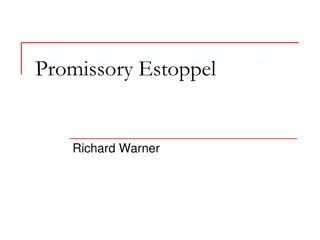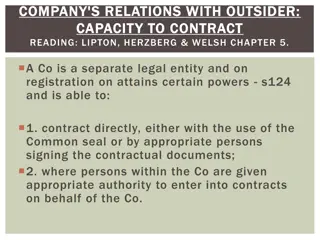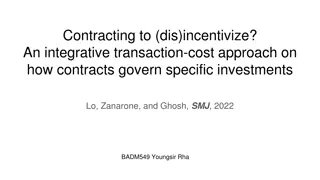Contractual Commitments and Governance Inseparability
Understanding the determinants of governance inseparability in firms, focusing on contractual commitments and changes in bargaining power. Discusses implications for governance efficiency over time and challenges in Transaction Cost Theory.
Download Presentation

Please find below an Image/Link to download the presentation.
The content on the website is provided AS IS for your information and personal use only. It may not be sold, licensed, or shared on other websites without obtaining consent from the author.If you encounter any issues during the download, it is possible that the publisher has removed the file from their server.
You are allowed to download the files provided on this website for personal or commercial use, subject to the condition that they are used lawfully. All files are the property of their respective owners.
The content on the website is provided AS IS for your information and personal use only. It may not be sold, licensed, or shared on other websites without obtaining consent from the author.
E N D
Presentation Transcript
Contractual Commitments, Bargaining Power, and Governance Inseparability: Incorporating History into Transaction Cost Theory Nicholas S. Argyres Julia P. Liebskind Academy of Management Review 24(1): 49 63 (1999)
Determinants of governance inseparability Two generative factors of governance inseparability: (1)Contractual commitments: The commitments engendered by long term contractual agreements which are costly to reverse or alter. (2)Changes in bargaining power: Increases in bargaining power for stakeholders (e.g. suppliers, customers, and employees) which pressure the firm to adopt suboptimal governance arrangements. Implication: Since most firms will experience (1) and (2), governance inseparability implies that most firms will become constrained and less efficient over time than TCE would predict. Especially since TCE focuses on transactions mostly in isolation, it is blinkered to the possibility of governance inseparability.
Transaction costs: Core assumptions Transaction as the basic unit of analysis. Firm is viewed as a managerial hierarchy, which is compared to primarily the market as the alternative organizing mechanism. Recall Coase (1937). Firms exist because they sometimes achieve more efficient resource allocation relative to the market for transacting (e.g. economic spillovers such as asset specificity and asset indivisibility). Scope of the firm is determined by vertical integration and diversification as responses to uncertainty, asset specificity, and other market frictions.
Constraints: Governance switching and differentiation A previous or current arrangement (X) precludes the firm from entering an alternative arrangement (Y) for some new transaction. Example: Franchising agreements A previous or current arrangement (X) requires the firm to enter a new arrangement (Y) with some new transacting party. Example: The prevention of corporations from committing to venturing. Interdivisional rivalry and conflicts.
Bargaining power and switching constraints Buyer (B) experiences increased bargaining power over Seller (S), which allows B to renegotiate such that S is precluded from forward integrating. Example: Unions using bargaining power to restrict outsourcing at GM.
Bargaining power: Differentiation constraints The bargaining power of internal stakeholders (employees) shifts such that these employees can block the firm from instantiating more efficient governance structures. Example: American Airlines and the internal strife over piloting short haul flights.
Governance inseparability: Some general implications 1. Governance inseparability impacts predictions about the relationship between features of specific transactions and their governance mechanisms. 2. Governance inseparability alters TCE s theory about the firm s scope and limits. 3. Governance inseparability calls for a closer integration between TCE, competition, and industry evolution.
Types of Governance Inseparability Constrained Governance Switching: (Cannot switch from type X to type Y governance) Constrained Governance Differentiation: (Cannot enter into another type of governance arrangement) Contractual Commitments: an agreement between two or more parties that is binding on those parties, to the degree that to renege on the agreement will be costly Formal and informal By necessity, usually long-term in nature and always incomplete Causes of Governance Inseparability Examples: Franchising agreements and exclusive dealerships Coca-Cola and independent bottling companies Examples: New venture division in a corporate structure Single transfer pricing rules Bargaining Power: the ability of one party to a contract to be able to influence the terms and conditions of that contract or subsequent contracts in its own favor Power increases unexpectedly and oftentimes gradually (long-term) Uncertain legal decisions/ environment Interrelated factors affecting relative power of contracting parties Examples: Unionized labor attempts to restrict outsourcing UAW strike against GM in 1996 Franchising and the growth of franchisee organizations (AFA and AAFD) Examples: Long-distance trucking companies seeking to enter short-haul industry American Airlines seeking to establish short-route subsidiary, American Eagle
Implications for the use of alternative governance mechanisms Proposition 1: Different firms may govern identical transactions in different ways, as long as each firm is also a party to other types of transactions. Proposition 2a: Compared with younger firms, older firms more often will be obligated to use market contracting to govern transactions featuring asset specificity for the same level of firm bargaining power. Proposition 2b: Compared with younger firms, older firms more often will be obligated to use hierarchical mechanisms to govern generic transactions for the same level of firm bargaining power. Proposition 3: Firms operating in jurisdictions in which labor unions are accorded more bargaining power will be obligated more often to use hierarchical mechanisms to govern generic transactions than will firms operating in jurisdictions in which labor union power is more restricted.
Implications for firm scope Proposition 4: The greater the difference is between a transaction s optimal governance mechanism and a firm s governance arrangements in place, the greater the cost will be to the firm of internalizing that transaction. Proposition 5: Greater uncertainty will reduce the vertical and horizontal scope of the firm. Takeaway: Governance inseparability can constrain a firm s governance alternatives in two ways. First, it may constrain a firm from switching from one governance mode to another for the same type of transaction. Second, it may obligate a firm to use an existing governance arrangement for a new transaction.
